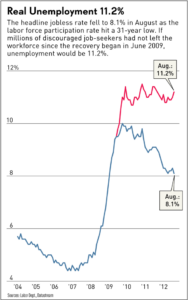Shrinking Labor Force, Weak Job Gains May Spur Fed
 Weak payroll gains and a labor force exodus in Friday’s jobs report suggest the economy is suffering long-term structural damage, as the Federal Reserve has feared. They may make new Fed action likely, but many question if that will do much good.
Weak payroll gains and a labor force exodus in Friday’s jobs report suggest the economy is suffering long-term structural damage, as the Federal Reserve has feared. They may make new Fed action likely, but many question if that will do much good.
Weak payroll gains and a labor force exodus in Friday’s jobs report suggest the economy is suffering long-term structural damage, as the Federal Reserve has feared. They may make new Fed action likely, but many question if that will do much good.
The 96,000 jobs the Labor Department said were created last month fell short of the 125,000 expected and marked the fourth month in five of sub-100,000 growth. June-July job gains were revised down by a total of 41,000.
The unemployment rate fell to 8.1% from 8.3%, according to the separate household survey. But that’s only because 368,000 people left the labor force, pushing the participation rate to a 31-year low of 63.5%. If workforce participation had held steady since the economic recovery began in June 2009, the jobless rate would be 11.2%.
The shrinking labor force in particular will concern Fed policymakers, says Steve Wyatt, a finance professor at Miami University’s Farmer Business School. “Those numbers are not consistent with a healthy recovery at all,” he said.
A day after his Democratic convention speech, President Obama said the jobs report was “not good enough.” GOP rival Mitt Romney said, “We’re going in the wrong direction.”
But stocks were little changed as investors bet on Fed action at its Sept. 12-13 meeting. That would follow the European Central Bank, which unveiled a bond-buying program Thursday, and China’s recent announcements of major infrastructure projects.
Fed Chairman Ben Bernanke warned that prolonged high unemployment could lead to structural damage, during an Aug. 31 speech in Jackson Hole, Wyo., where he strongly indicated more stimulus is coming.
Analysts saw Friday’s bleak data making Fed action more likely, though they are doubtful about how effective it can be.
“I think we have reached the end of what monetary policy can do,” Wyatt said.
Still, he expects Fed policymakers to extend their guidance for near-zero rates to 2015 from 2014. He also sees them beginning a third round of bond buying, or quantitative easing.
It could start with a modest extension of Operation Twist that involves more long-term purchases without fully offsetting them with short-term debt sales. After the election, the central bank could OK full-blown QE.
He also warned that a longer timeline for near-zero rates could even be counterproductive, if it reduces the urgency among businesses to take advantage of cheap loans.
The payroll data lacked signs of mass layoffs but showed firms aren’t hiring much outside of the leisure sector (34,000), professional services (28,000), and health and education (22,000).
But job gains in wholesale, retail, trade and transportation, finance, utilities and information were below 10,000. Manufacturers shed 15,000 workers, and governments cut 7,000.
Just 50.2% of industries added staff in August, the smallest share since February 2010.
Average hourly pay fell by a cent, and weekly hours were flat.
August’s jobs report was bad enough that more Fed action is “almost assured” this week, but not bad enough for large-scale QE yet, said Lance Pan, director of investment research and strategy at Capital Advisors Group.
Citing the political calendar, Pan also expects small-scale QE at first. But the pressure is on the Fed to be bold eventually.
“If they don’t do enough, Bernanke’s credibility is on the line,” Pan said.